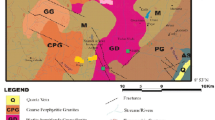Abstract
The uranium isotopes during their course of their disintegration decay into other radioactive elements and eventually decay into stable lead isotopes. The cause of environmental concern is the emanation of beta and gamma radiation during disintegration. The present study tends to estimate uranium in groundwater trapped in granite and gneiss rocks. Besides, the study aims at estimating the radiation during natural disintegration process. The water samples were collected and analyzed following inductively coupled plasma mass spectrometric technique while water sample collection was given to the regions of Kolar District, South India, due to the representation. The significant finding was the observation of very high levels of uranium in groundwater compared to similar assays reported at other nearby districts. Also, the levels were considerable to those compared to groundwater levels of uranium reported by other scientists. On the basis of this study, it was inferred that the origin of uranium was from granite strata and there was a trend of diffusion observed in the course of flow-path of water in the region.
Similar content being viewed by others
References
Almeida, R. M. R.; Lauria, D. C.; Ferreira, A. C.; Sracek, O., (2004). Groundwater radon, radium and uranium concentrations in Regiao dos Lagos, Rio de Janeiro State, Brazil. J. Environ. Radio., 73(3), 323–334.
APHA (1995). Standard methods for the examination of water and wastewater, 19th. Ed., Public health association, American water works Association and water environment fedration, USA. 9-1-9-63.
Athavale, R. N.; Rangarajan, R.; Rao, S. M., (1992). Determination of the flow direction of geothermal water at Manikaran using the bore hole tracer technique. J. Geol. Soc. India. 39, 329–337.
Bleise, A.; Danesi, P. R.; Burkart, W., (2003). Properties use and health effects of depleted uranium (DU): A general overview. J. Environ. Radio., 64(2–3), 93–112.
CWC (2000). Water and related statistics, Central Water Commission, Ministry of Water Resources, Govt. of India, New Delhi, India
Dillon, M. E.; Carter, G. L.; Arora, R., and Kahn, B., (1991). Radon concentrations in ground water of the Georgia piedmont., Health Physics., 60(2), 229–236.
District Report at a glance, District Statistical Department (2002-2005).
Fontes, J., (1983). Dating of groundwater, In: Guidebook of Nuclear techniques in Hydrology, Technical Report Series No. 91, International Atomic Energy Agency, Vienna, 285–317.
Guogang Jia, Maria Belli, Umberto Sansone, Silvia Rosamilia and Stefania Gaudino. (2005). Concentration and characteristics of depleted uranium in water, air and biological samples collected in Serbia and Montenegro. Appl. Radiat. Isotopes, 63(3), 381–399.
Hakam, O. K.; Choukri, A.; Moutia, Z.; Chouak, A.; Cherkaoui, R.; Reyss J. L.; Lferde, M., (2001). Uranium and radium in groundwater and surface water samples in Morocco, Radiat. Phys. Chem., 61(3), 653–654.
Hess, C. T.; Michel, J.; Harton, T. R.; Procured, H. M.; Coniglio, W. A., (1985). The occurrences of radioactivity in public water supplies in United States., Health Phys., 48(5), 553–86.
Iyengar, M. A. R., (1990). The natural distribution of radium. The environmental behaviour of radium. Technical Reports Series No. 310, Int. Atomic Energy Agency, Vienna, 59–128.
Lal, D.; Suess, H. E., (1968). The radioactive of the atmosphere and hydrosphere. Ann. Rev. Nuclear Sci., 18, 407–434.
Lawrie, W. C.; Desmond, J. A.; Spence, D.; Anderson, S.; Edmondson, C.; (2000). Determination of radium-226 in environmental and personal monitoring samples., Appl. Radiat.Isotopes, 53(1), 133–137.
Mahesh, H. M.; Avadhani, D. N.; Someshekarappa, H. M.; Karunakara, N.; Narayana, Y., and Siddappa, K., (2001). Uranium concentration in water samples in the environment of coastal Karnataka and Kaiga. Proc. Nat. Sem. Atom. Energ. Ecol Environ., 113–116.
Manjunath, S., (2002). Ph.D. Thesis published by University of Mysore. Investigation of the Environmental radioactivity in uranium bearing quartz pebble conglomerate horizon around Chickmagalur., Department of Studies in Physics., Manasagangotri, University of Mysore.
Orloff, K. G.; Mistry, K.; Charp, P., (2004). Human exposure to uranium in groundwater. Environ. Res., 94(3), 319–326.
Padam Singh, N. P. S.; Ameer A.; Naqvi, A. H.; Srivasan, D. S., (1995). Uranium contents in various water samples of Kanpur as determined by fission track technique., Proc. of 14th. National Symposium on Environment., 201–4.
Panziquiang, Y. Y.; Guo M., (1988). National radiation and radioacivity in china radiation. Protec. Dosimetry., 24(1/ 4), 29–8.
UNSCEAR., (1982). Ionizing Radiation: Sources and biological effects., UN Report., New York.
Author information
Authors and Affiliations
Corresponding author
Rights and permissions
About this article
Cite this article
Babu, M.N.S., Somashekar, R.K., Kumar, S.A. et al. Concentration of uranium levels in groundwater. Int. J. Environ. Sci. Technol. 5, 263–266 (2008). https://doi.org/10.1007/BF03326020
Received:
Revised:
Accepted:
Published:
Issue Date:
DOI: https://doi.org/10.1007/BF03326020




